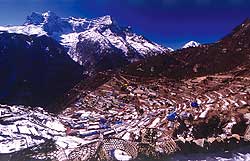 Namche Bazar wasn't quite prepared for the Chirstmas-New Year rush of trekkers last month, but no one here is complaining. The lodges are not 100 percent full, but owners say they haven't seen a winter with this many trekkers in a long time.
Namche Bazar wasn't quite prepared for the Chirstmas-New Year rush of trekkers last month, but no one here is complaining. The lodges are not 100 percent full, but owners say they haven't seen a winter with this many trekkers in a long time. Namche's restaurant owners and hotel managers who by now would be in Kathmandu only to return in spring, are staying on this winter. Many people here have varying explanations for this, but two seem to stand out: the worldwide publicity of the Everest 50th Anniversary event, which is still lingering, as well as some trekking traffic diverted from the Annapurna circuit because of news of Maoist extortion there. Ghandrung's loss, therefore has been Namche's gain.
No one has done an exact tally, but information from the national park and other sources say the trekking arrival figures for 2003 was as good as Visit Nepal Year 1998, when over 35,000 trekkers visited the Everest region.
 The rush can be seen in Lukla airport itself. If the visibility is good in Kathmandu, the Lukla flights start taking off at 6:45. On one day in December just before Christmas Day, there were 50 flights from Kathmandu and Phaplu, and Yeti Airlines alone is regularly doing 15 flights a day. Not all carry passengers, half the flights carry cargo or a mix of cargo and passengers. Some up market tourists staying at the Everest View Hotel fly directly to Syangboche.
The rush can be seen in Lukla airport itself. If the visibility is good in Kathmandu, the Lukla flights start taking off at 6:45. On one day in December just before Christmas Day, there were 50 flights from Kathmandu and Phaplu, and Yeti Airlines alone is regularly doing 15 flights a day. Not all carry passengers, half the flights carry cargo or a mix of cargo and passengers. Some up market tourists staying at the Everest View Hotel fly directly to Syangboche. The trekking demographics is also changing. No more is there a predominance of Americans and Britons. They have been replaced by more exotic nationalities: Koreans, Israelis and a growing number of South Americans. There are advantages to being a Nepali trekker here, since there are so few of us. Thanks to NTB, there is even a name for Kathmandu people who go hiking for pleasure and not for business: 'Antarik Paryatak'. But Nepali trekkers like me form less than one percent of the visitors to Khumbu.
Many along the trail, once they found out I was Nepali, would ask me which trek group I was leading. When I replied that I was just here to take pictures, they were surprised. But nowhere were they dismissive after finding out I was Nepali, as happens elsewhere where waiters and receptionists tend to pay more attention to 'genuine tourists' than 'domesticated tourists'.
 Namche is now firmly ensconced in the global village. There are internet cafes, VSAT phone booths all along the trail, pool parlours and cable television. There will be the purists who will lament this modernisation and wish Namche remained the yak town it used to be 50 years ago. But for the people of Namche, there is no doubt which is better.
Namche is now firmly ensconced in the global village. There are internet cafes, VSAT phone booths all along the trail, pool parlours and cable television. There will be the purists who will lament this modernisation and wish Namche remained the yak town it used to be 50 years ago. But for the people of Namche, there is no doubt which is better. The trail from Namche to Tengboche is thick with snow. The pine and fir forests are thick, with flocks of danphes flapping off into the undergrowth when accosted while sunning themselves on a rock. Despite the number of tourists and the encroachment of modern media, the Everest trail in winter is still a great place for those getting low on battery to go up to recharge.
Lukla is surprisingly affordable for Nepalis, the local fare roundtrip is Rs 3,600. (It is just under $100 for foreigners and some airlines offer a special rate for Indians.) It is a standard Rs 100 per tourist for a room and food prices are standard.


